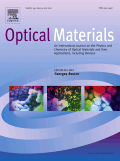
OPTICAL MATERIALS
metrics 2024
Exploring the Frontiers of Optical Innovation
Introduction
OPTICAL MATERIALS is a peer-reviewed journal published by Elsevier, focusing on the intricate field of optical materials within various scientific domains including atomic and molecular physics, electronic engineering, and chemistry. With an impact factor indicative of its relevance, it ranks in the Q2 category across multiple areas such as Electrical and Electronic Engineering, and Inorganic Chemistry, highlighting its critical position in advancing research and innovation. Established in 1992 and continuing its contribution until 2024, this journal serves as a vital resource for researchers and professionals aiming to disseminate significant findings in material sciences, particularly those related to optical properties and applications. While it does not offer open access, the journal remains essential for academia and industry alike, ensuring the continued exchange of valuable knowledge in this rapidly evolving field.
Metrics 2024
 0.65
0.65 3.80
3.80 3.50
3.50 119
119Metrics History
Rank 2024
Scopus
IF (Web Of Science)
JCI (Web Of Science)
Quartile History
Similar Journals

Frontiers of Optoelectronics
Pioneering Research in Electrical and Optical EngineeringFrontiers of Optoelectronics is a prestigious peer-reviewed journal published by HIGHER EDUCATION PRESS, focusing on the rapidly evolving fields of electrical engineering, optical science, and material science. With its inception in 2012 and an impressive impact factor achieved by being ranked Q1 in both Electrical and Electronic Engineering and Electronic, Optical and Magnetic Materials as of 2023, this journal exemplifies excellence in research dissemination. Operating under an Open Access model since 2022, it ensures timely and widespread accessibility to cutting-edge advancements and innovative applications in optoelectronics, making it an essential resource for researchers, professionals, and students alike. The journal is indexed in Scopus, with notable ranking positions—Rank #143/797 in Electrical and Electronic Engineering and Rank #55/284 in Electronic, Optical and Magnetic Materials—highlighting its significant contribution to the academic community. Based in Beijing, China, the journal fosters a global dialogue around key technological trends, ultimately driving further development in the field.

SUPERLATTICES AND MICROSTRUCTURES
Transforming ideas into impactful research outcomes.SUPERLATTICES AND MICROSTRUCTURES is a premier journal dedicated to the exploration and dissemination of cutting-edge research in the fields of Condensed Matter Physics, Electrical and Electronic Engineering, and Materials Science. Published by Academic Press Ltd - Elsevier Science Ltd, this journal has established itself as an important platform for scholars and industry professionals to share their findings related to the design, fabrication, and application of superlattices and microstructured materials. With a commendable impact factor reflected in its rankings—positioned within the top quartile in Physics and Astronomy as well as Electrical and Electronic Engineering—it offers high visibility and influence in the academic community. The journal has covered significant contributions from 1985 to 2022, although access options have transitioned, making staying current essential for researchers and practitioners alike. This journal not only serves as a repository of knowledge but also fosters collaboration and innovation in materials science and related disciplines.

eLight
Illuminating the Future of Atomic and Molecular PhysicseLight is a leading academic journal published by SPRINGER NATURE, dedicated to the dynamic field of Atomic and Molecular Physics, as well as Electronic, Optical, and Magnetic Materials. Launched in 2021, the journal has quickly established itself as a reputable source of cutting-edge research, evidenced by its impressive Q1 quartile rankings in both categories for 2023, alongside remarkable Scopus rankings that place it in the top 2% of its fields. With a commitment to advancing knowledge and fostering innovation, eLight invites contributions from researchers, professionals, and students who are passionate about exploring new frontiers in these critical areas of study. Hitting a critical intersection of physics and materials science, the journal provides an open forum for the dissemination of experimental findings, theoretical studies, and application-based research, ensuring accessibility to vital discoveries that drive progress in technology and academia. Located in Singapore, eLight is poised to make significant contributions to the scientific community until at least 2024, and beyond.

Journal of Luminescence
Pioneering Insights into Luminous PhenomenaThe Journal of Luminescence, published by ELSEVIER, is a leading interdisciplinary journal focused on the exploration of luminescence phenomena and applications across various scientific fields. Established in 1970, this prestigious journal has made significant contributions to the realms of Atomic and Molecular Physics, Biochemistry, Biophysics, Chemistry, and Condensed Matter Physics, as evidenced by its commendable Scopus rankings and category quartiles. As of 2023, it holds a Q2 ranking in multiple categories, indicating a robust impact in the community. The journal serves as a vital platform for researchers, professionals, and students alike, offering insights into the latest advancements in luminescence research and related applications, fostering innovation in both theoretical and experimental frameworks. The journal provides enriching content through its non-open access model, ensuring high-quality peer-reviewed research is accessible to those who prioritize impactful scholarly work. With a convergence period extending to 2025, the Journal of Luminescence continues to be an essential resource for those dedicated to the advancement of knowledge in the luminous sciences.

JOURNAL OF OPTOELECTRONICS AND ADVANCED MATERIALS
Connecting Ideas, Inspiring Innovations in OptoelectronicsJOURNAL OF OPTOELECTRONICS AND ADVANCED MATERIALS, published by the NATL INST OPTOELECTRONICS in Romania, is an esteemed academic journal dedicated to disseminating innovative research in the fields of optoelectronics and advanced materials. With an ISSN of 1454-4164 and E-ISSN 1841-7132, the journal provides a platform for researchers to share their findings and technological advancements from 1999 to 2024. Despite being placed in the Q4 quartile across several categories—including Atomic and Molecular Physics, Condensed Matter Physics, and Electrical and Electronic Engineering—the journal serves as an essential resource for highlighting significant developments in its respective fields. Researchers and professionals may find valuable insights that foster collaboration and inspire further investigation, thereby contributing to the continuous evolution of optoelectronics and materials science.

APPLIED OPTICS
Unveiling the Science of Light and Its ApplicationsApplied Optics, published by Optica Publishing Group, is a prestigious journal dedicated to the field of optics and photonics. With an ISSN of 1559-128X and an E-ISSN of 2155-3165, this journal serves as a critical platform for researchers, professionals, and students eager to disseminate innovative findings and advancements in applied optics. Established in 1962, it has maintained a significant presence in the academic community, currently holding a Q2 category ranking in various disciplines including Atomic and Molecular Physics, Electrical and Electronic Engineering, and Miscellaneous Engineering as per the 2023 metrics. The journal's reputation is underscored by its solid Scopus rankings, attesting to its influential research output. While not an open-access journal, it continues to offer vital insights and discussions on the latest research topics that are critical to the advancement of technologies in optics, ensuring accessibility to vital knowledge for those within the field.

Advances in Physics-X
Pioneering the Future of Physics and AstronomyAdvances in Physics-X is a premier open-access journal published by Taylor & Francis Ltd, dedicated to advancing the frontiers of knowledge in the field of Physics and Astronomy. Since its inception in 2016, the journal has established itself as a vital platform for researchers and professionals, showcasing innovative research and cutting-edge theories that influence a broad array of sub-disciplines within physics. With an impressive impact factor and ranked in the 94th percentile among its peers, it resides in the Q1 category for Physics and Astronomy (miscellaneous), indicating its significant contributions to the academic community. Located in the United Kingdom, the journal encourages open access to foster wider dissemination and visibility of scholarly works, aligning with contemporary academic trends that prioritize global knowledge sharing. The ongoing commitment to publishing high-quality research ensures that Advances in Physics-X remains an essential resource for students, industry experts, and academics alike, helping to shape the future of physics research through collaboration and innovation.

Photonics, an esteemed journal published by MDPI, is a leading platform for researchers in the fields of atomic and molecular physics, optics, and instrumentation. Since its inception in 2014, the journal has fostered open access to cutting-edge research, facilitating knowledge dissemination in these dynamic disciplines. With its Q2 ranking in the 2023 Scopus metrics for various categories, including radiology, nuclear medicine, and imaging, Photonics represents a crucial academic resource for professionals and students seeking to advance their understanding and expertise. Located in Basel, Switzerland, the journal plays a pivotal role in bridging theoretical and practical approaches to photonic technologies. Researchers are encouraged to contribute their findings, thereby enriching the journal’s impact and relevance in the global scientific community through collaboration and innovation.

CURRENT APPLIED PHYSICS
Empowering Researchers to Shape the Future of Physics.Current Applied Physics is a leading journal published by Elsevier, specializing in the dynamic fields of Physics and Materials Science. With an ISSN of 1567-1739 and an E-ISSN of 1878-1675, this journal focuses on the latest advancements and applications of physics principles in various practical domains. Operating from the innovative hub of Amsterdam, Netherlands, Current Applied Physics occupies a significant niche in the scientific community, evidenced by its Q2 ranking in both the Physics and Astronomy and Materials Science categories for the year 2023, along with impressive Scopus rankings that highlight its relevance in the fields of General Physics and General Materials Science. The journal's scope encompasses a wide range of topics, fostering interdisciplinary collaboration and facilitating the exchange of knowledge among researchers, professionals, and students. Each issue features peer-reviewed articles that contribute to the understanding and application of physical sciences, making it an essential resource for those aiming to stay at the forefront of research and innovation in applied physics.

ECS Journal of Solid State Science and Technology
Advancing the Frontiers of Solid State ResearchECS Journal of Solid State Science and Technology, published by the Electrochemical Society, is a prominent journal dedicated to the advancement of research in the field of electronic, optical, and magnetic materials. With an ISSN of 2162-8769 and an E-ISSN of 2162-8777, this journal has established a significant presence since its inception in 2012, spanning critical developments in solid-state science that are essential for innovative technologies. Operating within the United States and recognized for its global outreach, it holds a respectable Q3 category ranking in the materials science category as of 2023, reflecting its commitment to high-quality research and its role in bridging theoretical and applied aspects of materials science. Researchers, professionals, and students alike will find vital information and cutting-edge studies that further the understanding and applications of solid-state technologies. The journal is accessible to an extensive audience, making it an invaluable resource for those engaged in the ever-evolving landscape of materials science.